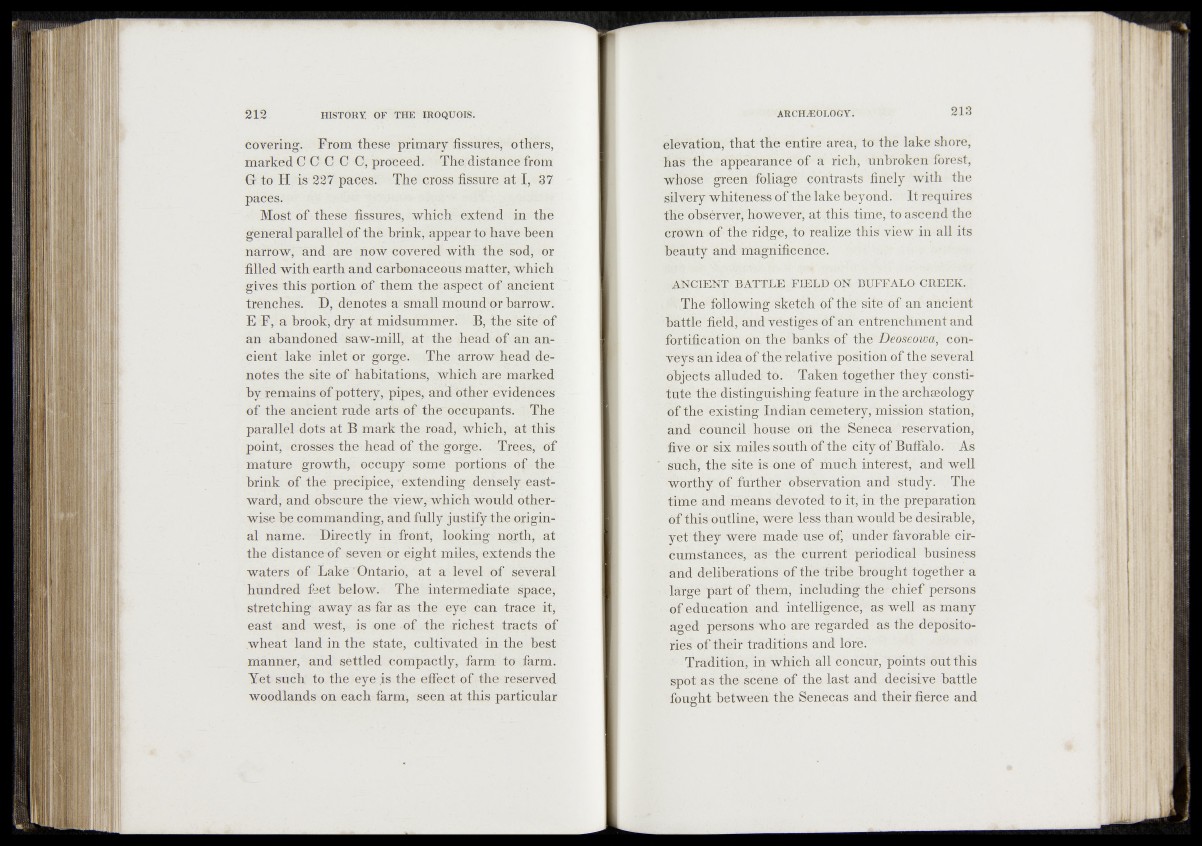
covering. From these primary fissures, othéÿs,
marked C G C C C, proceed . The distan ce from
G to II is 227 paces! The cross fissure at I, 37
paces,
Most of these fissures, which extend in the
general parallel of the brink, appear to have heen
narrow, and are now covered with the sod, ór
filled with earth and carbonaceous matter, which
gives this portion of them the. aspect of ancient
trenches. D, denotes a small mound or harrow.
E F, a brook, dry at midsummer. B, the site of
an abandoned saw-mill, at the head of an ancient
làke inlet or gorge. The arrow head dénotes
the site of habitations, which are marked
by remains of pottery, pipes, and b'fher evidences
of the ancient rude arts of the^occupants. The
parallel dots at B mark the road, which, at this
point, crosses the head of the égorge. Tre.es,' o'f
mature growth, occupy some portions of-the
brink of the precipice, ‘extending densely eastward,
and obscure the view, which would otherwise
be commanding, and fhlly justify the original
name. Directly in front, looking' north, at
the distancent seven ör eight miles,sextends the
waters of Lake’Ontario, at a level of several
hundred feet below. The intermediate space;
stretching away as far as thé eye can trace it,
east and west,£ is one of the richest tracts of
wheat land in the state, cultivated'in the best
manner, and settled compactly, farm to farm.
Yet such to the eye is the effect of «the reserved
woodlands on each farm* seen at this particular
elevation, that the entire area, to the lake shore,
has the appearance of a rich, unbroken forest,
whose green foliage contrasts firiely with the
silvery whiteness of the lake beyond. It requires
■|lé;ehsèr#fi%)wevëi5 at ^Ms. time, to ascend the
crown ©£> the ridge, to realize this view in all its
beauty and magnificence.
ANCIENT BATTLE FIELD 'ON BUFFALO CREEK.
f\ (The following sketch of th#situ óf an ancient
battle fiêld' and vestiges of an entrenehmenfand
fortification ©n the banks of th&'Deoseowd,' conveys
an idea of thé relative poSitiofcof the several
objects alluded/tö. Taken together they constitute
the distinguishing featurednthe archseology
of the existing Indian cemetery, mission station,
and ’ cauncil, höusè' on the cSéhéCa 'reservation,
five-or six miles south of the city of Buffalo. As
such, the site is one of much interest,'1 and well
worthy of further observation and study. The
time and means devoted tbit; fn the preparation
of this outline, were'-lé$S'than would be desirable,
yetfhëy were made use'of; undertfavorhMë circumstances,
as1" the'current periodical business
and deliberations Of the tribe brought together a
large part of them, itMuding the ■ chief persons
> of education and intelhgfeê'éjvas well as many
aged prisons who are regarded as the depositories
of their traditions and löré;;u
’ Tradition, in which all concur, points out this
spot fis the scene of the last and decisive battle
fought between the Senecas and their fierce and